
Andy Lloyd's Dark Star Blog

Blog 69 (December 2018)
New Cometary Planets
Two studies regarding the escaping atmospheres of hot exoplanets have been published this month in the journal Science (1,2). The first is a transiting warm Neptune-mass exoplanet located 20 times nearer its host star than the Earth is to the Sun. The tail of helium being blasted away from this planet by radiation from its orange dwarf host star extends some five planetary radii out. The planet, known as HAT-P-11b, is blown up like a helium balloon, according to the researchers who have been studying it (3).
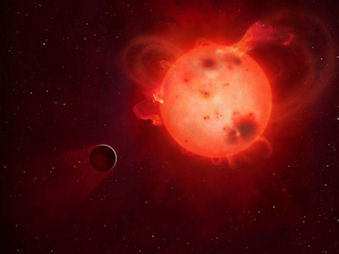
Image credit: Mark A. Garlick / University of Warwick (10)
However, HAT-P-11 is not a young star still blasting away at the primordial atmosphere of a new Neptune-sized world, as you might expect. Instead, HAT-P-11 is 6.5 billion years old; almost 2 billion years old than our own Sun. So, why is it still managing to have such a devastating effect upon the Neptune-sized exoplanet in its midst? Common sense would dictate that you can't have such an effect going on for 6.5 billion years, as the planet would have been eradicated long ago. Loosely bound helium held in this gaseous 'envelope' would surely leak out into space in considerable quantities over time?
Like with comets repeatedly transiting around their stars at perihelion, you would think that at some point the volatile gases would all get blown away. Perhaps HAT-P-11b was once a much greater hot Jupiter world which has shrunk to Neptune proportions over time. Or, perhaps this is a case of inwards migration of this world from further out in the star system.
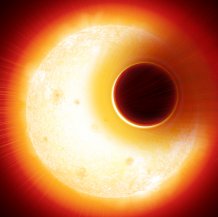
Image Credit: Denis Bajram (3)
A similar tail of atmospheric helium is being blasted back from another giant exoplanet, this time known as WASP-69b (5). This world is about a quarter of the mass of Jupiter, making it a sub-'hot Jupiter' object. The discovery of this helium tail was also made using the Carmenes instrument, installed on the 3.5-meter telescope of the Calar Alto Observatory in Spain. In this case, the host star, is 2 billion years old and just a little smaller than our own Sun (6), making it another orange dwarf. So, again, this effect isn't due to the young nature of the system - there is a sustained effect taking place over a long period of time if the system has been static for that entire time. How long can such helium leakage be sustained from this 'evaporating exoplanet'? Previous discoveries of such leaking exoplanets have included a 'hot Neptune' planet whizzing around a ~9 billion year old red dwarf, Gliese 436 (7).
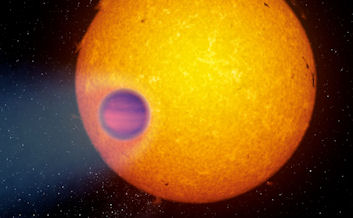
Image Credit: Gabriel Perez Diaz, SMM (IAC) (5), adapted by Andy Lloyd
Evidently, these hydrogen and helium 'envelopes' can be remarkably long-lasting. But that is not always the case. Other 'hot' Neptunes may shed so much atmospheric material that they end up as smaller planets. This is thought to be the case for the hot Neptune planet GJ 3470b, whose superheated atmosphere is evaporating off at a rate 100 times faster than that of Gliese 436b (8). During its 2 billion lifetime, it may already have lost a third of its mass to the radiation pressure of its star, and within several billion more years, it could be left a mere rocky, terrestrial world (one would assume that as the planet loses mass, the process of atmospheric evaporation would accelerate - there is less gravity to keep it held to the bombarded world).
The knowledge that GJ 3470b is losing its atmosphere so quickly suggests that other hot Neptunes may have eroded down to smaller, rocky super-Earths. This effect might then explain a the relative dearth of such objects among exoplanets (9). Smaller exoplanets which have been discovered close to their parent red dwarf stars also seem to have been shorn of their atmospheres by powerful flares and coronal mass ejections - a phenomenon which red dwarfs seem quite prone towards (10).
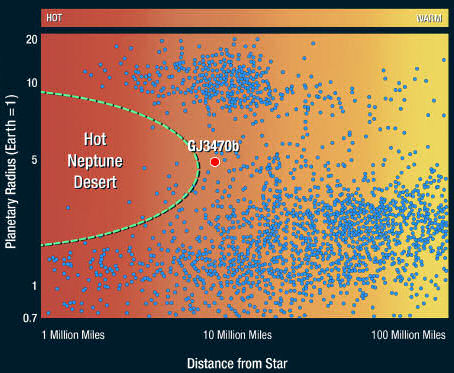
Image credit: NASA / ESA / A. Feild, STScI (8). This graphic plots exoplanets based on their size and distance from their star
Why is this important? Because it indicates that planets can appear like comets, under the right circumstances. The volatile gases wrapped up in the atmospheres of Neptune-sized worlds can become drawn out into what must be rather fabulous looking envelopes of gas. These effects are being noticed in the specific cases of exoplanets which are located very close to their stars. This is reasonable in the sense that the planets are subjected to the ultraviolet radiation and stellar winds at this proximity. But, the reason we're seeing this in these cases is that the planets are transiting the stars, allowing measurement of their extended atmospheres to be taken. That creates bias towards very close planets.
It may also be true that Neptune-sized planets located further out from these orange and red dwarfs could be exuding atmospheric hydrogen and helium. Observational bias dictates that we only see the effect with their closer exoplanetary cousins. This potentially means that Neptune-sized worlds on eccentric, comet-like trajectories might be highly spectacular in nature during their perihelion passages - true cometary planets.
Written by Andy Lloyd, 7
-15th December 2018
References:
1)
R. Allart et al., "Spectrally resolved helium absorption from the extended atmosphere of a warm Neptune-mass exoplanet," Science (2018).2) L. Nortmann et al., "Ground-based detection of an extended helium atmosphere in the Saturn-mass exoplanet WASP-69b," Science (2018)
3) University of Exeter Press Release "Helium exoplanet inflated like a balloon, research shows" 6 December 2018
4) "Planet HAT-P-11 b"
5) Instituto de Astrofísica de Canarias Press Release: "Helium signal reveals the comet-like tail of exoplanet WASP-69b for the first time" 6 December 2018
6) "Planet WASP-69 b"
7) B. Lavie et al. "The long egress of GJ 436b’s giant exosphere" Astronomy & Astrophysics 605, L7 (2017)
8) V.Bourrier et al. "Hubble PanCET: An extended upper atmosphere of neutral hydrogen around the warm Neptune GJ 3470 b" Astronomy and Astrophysics, 14 December 2018
9) Sci News Staff " Hubble Finds Fast-Evaporating Warm Neptune: GJ 3470b" 14 December 2018
10) Sergio Prostak "Kepler-438b: Red Dwarf May Have Stripped Away Atmosphere of Earth-Like Exoplanet" 18 November 2015
An Extraordinary Binary Coupling
There's evidence to suggest that all stars begin life in a binary litter, known as a 'dense core' (1). Many of these binary units remain intact, providing the universe with a steady supply of binary stars. Others seem to break apart, flinging the companion object into interstellar space - a rejected runt left to fend for itself within the galactic streams. Spotting binary stars which have relatively similar masses is easy enough. What is less clear is whether tiny companion objects, formed within these dense cores, set up shop within planetary systems, hiding beyond out sight within the outer darkness of their sibling star's system.
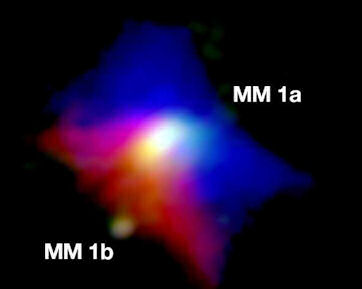
Image Credit: J. D. Ilee / University of Leeds
A directly imaged example of such a system has been reported this month, which amply illustrates the potential for such companion objects. A young massive star, forty times more massive than the Sun, has been found to have a companion star in orbit around it whose own mass is about half that of our Sun (2). This means that this young binary pair has a comparative mass ratio of 80:1 (3).
Now, if we were to bring this down to a star system where the main star was the mass of the Sun, its companion object would be be an 1/80 of the mass of the Sun. Such an object would be about 13 Jupiter masses, which is at the lowest mass range from brown dwarfs. The implication of this is that our Sun might have spawned a low mass brown dwarf during its formation. This may be a bi-product of the spinning disk as the primordial disk collapses under its own gravity (2), or, alternatively, the result of a spindling effect due to a passing star within the stellar nursery, as suggested by
François Berguerand (4).It's likely, I suggest, that such disparate binaries are common. In effect, they could have been the precursor for each 'single' star we see in the sky. After the initial paring form, the companion is either lost to interstellar space, or becomes loosely bound within the outer reaches of the star system. Perhaps, in some cases, it erodes over times due to its ongoing proximity to the main star blasting away at its atmosphere with ultraviolet radiation. This appears to be the case with certain 'hot' Neptune exoplanets, as discussed in the blog piece above (5).
Conceptually, this would support the notion that many brown dwarfs occur in situ within much more massive star systems, rather than independently in interstellar space.
Written by Andy Lloyd, 15th December
2018
References:
1)
Robert Sanders "New evidence that all stars are born in pairs" 13 June 2017,2) Leeds University Press Release "A young star caught forming like a planet" 14 December 2018
3) J. Ilee et al "G11.92-0.61 MM1: A Fragmented Keplerian Disk Surrounding a Proto-O Star". Astrophysical Journal Letters, Dec 2018, 869(2)
4) Andy Lloyd "Our Solar System: An Alternative Birth" 25 September 2015,
andylloyd.org/darkstarblog30.htm
5) V. Bourrier et al. "Hubble PanCET: An extended upper atmosphere of neutral hydrogen around the warm Neptune GJ 3470 b" Astronomy and Astrophysics, 14 December 2018
More Planets Hidden in Dust
A new survey of protoplanetary disks in the star-forming region in the constellation Taurus have determined that a considerable proportion of the planets emerging from these young disks are super-Earths and mini-Neptune worlds (1,2). This is in keeping with the high incidence of super-Earths and mini-Neptune worlds among the known exoplanets, and helps to confirm the ubiquitous nature of these worlds.
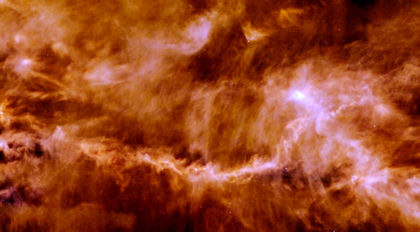
Image Credit: ESA/Herschel/PACS, SPIRE/Gould Belt survey Key Programme/Palmeirim et al. 2013
The survey picked up many fainter protoplanetary disks, which removed some of the observational bias previously favouring the discovery of disks containing more massive, Jupiter-sized worlds.
"The [international]
team measured the properties of rings and gaps observed with ALMA and analyzed the data to evaluate possible mechanisms that could cause the observed rings and gaps. While these structures may be carved by planets, previous research has suggested that they may also be created by other effects. In one commonly suggested scenario, so-called ice lines caused by changes in the chemistry of the dust particles across the disc in response to the distance to the host star and its magnetic field create pressure variations across the disk. These effects can create variations in the disk, manifesting as rings and gaps."The researchers performed analyses to test these alternative explanations and could not establish any correlations between stellar properties and the patterns of gaps and rings they observed. "We can therefore rule out the commonly proposed idea of ice lines causing the rings and gaps," [Paola] Pinilla [a NASA Hubble Fellow at the University of Arizona's Steward Observatory] said. "Our findings leave nascent planets as the most likely cause of the patterns we observed, although some other processes may also be at work."" (1)
So, super-Earths continue to be the most populous exoplanet category, both in terms of known objects, and the spread of dusty rings they emerge from. This, despite their seeming absence within our own solar system.
Written by Andy Lloyd,
7th December 2018References:
1)
Daniel Stolte: University of Arizona Press Release: "Unknown Treasure Trove of Planets Found Hiding in Dust" 6 December 20182) Feng Long et al. "Gaps and Rings in an ALMA Survey of Disks in the Taurus Star-forming Region", The Astrophysical Journal 869(1): 17, 6 December 2018
Farout!
Farout is the nickname that has been given to a new dwarf planet which is the furthest solar system object to have been spotted yet by telescopes. An international team using telescopes in Hawaii and Chile have determined that this slow-moving scattered disk object, known officially as 2018 VG18, is located somewhere between 125 and 130 Astronomical Units away (1). As a result, Farout's orbital period is over 1000 years long The object is pinkish, spherical in shape, and probably about 500 km across (2); but at this distance it's difficult to say much more about it.
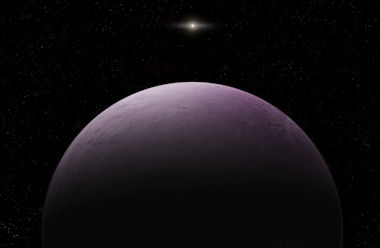
Image Credit: Roberto Molar Candanosa/Carnegie Institution for Science
Importantly, it may add to the enigmatic clustering of extended scattered disk objects beyond the Kuiper belt (3), and therefore to the body of evidence suggesting the presence of a Planet X object well beyond this distant point in the solar system:
"2018 VG18 is much more distant and slower moving than any other observed solar system object, so it will take a few years to fully determine its orbit," Scott Sheppard, a researcher at the Carnegie Institution for Science in Washington, D.C., and member of the discovery team, said in the statement. "But it was found in a similar location on the sky to the other known extreme solar system objects, suggesting it might have the same type of orbit that most of them do. The orbital similarities shown by many of the known small, distant solar system bodies was the catalyst for our original assertion that there is a distant, massive planet at several hundred AU shepherding these smaller objects." (2)
The gap between the Kuiper belt and the inner Oort cloud (IOC) is starting to pick up a decent population of objects. Depending upon their perihelia and aphelia distances, inclination and other orbital properties, these extreme trans-Neptunian objects (ETNOs) might be compartmentalisable into different groupings.
Image Credit: Scott Sheppard & Chad Trujillo (3)
As objects in the solar system are being increasingly understood to have had a dynamic history, migrating from position to position over time due to complex perturbing effects during the lifetime of the solar system, it's reasonable to wonder whether objects out in this no-man's land might once have been cometary objects that originated from the IOC which migrated inwards, or, alternatively, Kuiper Belt Objects (KBOs) which have been scattered, or drawn, outwards.
The presence of a massive Planet X object could have manifested both of these possible routes. Further, the massive perturbing object could also play a shepherding role; organising the distant dwarf planets into a orderly dance troop which share common arguments and longitudes of perihelia, which remain stable over long time periods. This shepherding effect, if it is real, seems the most likely reason for the observed cluster, and the more objects that are found to fit into this emerging pattern (countered by those that don't), the stronger the statistical evidence for the existence of Planet X. 2018 VG18 may turn out to be another one of those objects, but to find that out we will likely have to wait until the incredible scoping power of modern astrophysics increases once again, as the next generation of telescopes comes online.
Written by Andy Lloyd, 21st December
2018References
:1) IAU Minor Planet Center "Minor Planet Electronic Circulars: MPEC 2018-Y14 : 2018 VG18" 17 December 2018
2) Sarah Lewin "'Farout!' Newfound Object Is the Farthest Solar System Body Ever Spotted" 17 December 2018 with thanks to Korbyn and Lee
3) Scott Sheppard & Chad Trujillo "New Extreme Trans-Neptunian Objects: Towards a Super-Earth in the Outer Solar System" The Astronomical Journal, August 2016, 152(6)
Approaching Ultima Thule
Following its remarkable flyby of Pluto in 2015, the New Horizons probe
has been winging its way into the Kuiper belt, seeking out objects to
image as it goes along. At the time of writing, it is fast
approaching the first such Kuiper belt Object, 2014 MU69,
which has been nicknamed Ultima Thule. On New Year's Day, New Horizons
will approach Ultima Thule at a distance of
just 2,200 miles, which is a third of the distance it achieved
with Pluto. However, this time the reddish object being studied is
just 19 miles across, making it a tricky target to focus upon as the
probe whips past in the darkness of the Kuiper belt.
Image Credit:
NASA/JHUAPL/SWRI/Steve Gribben
and adapted by Andy Lloyd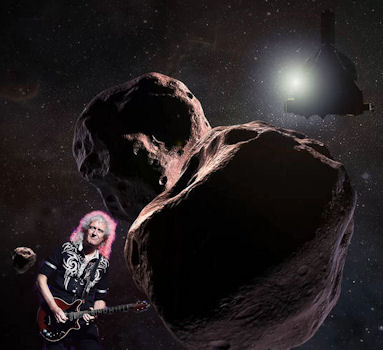
Potentially, this flyby will be hazardous to the probe. Little is known about the object, beyond the fact that it is not spherical. It may elongated, a binary object or even a series of objects. It may also have a dusty sheath around it, which may explain the lack of a 'light curve' which was expected to be reflected back from Ultima Thule (1). As the probe approaches, the reason for the tiny light curve will become clearer, but at the moment several explanations have been offered:
""It's possible that Ultima's rotation pole is aimed right at or close to the spacecraft," said Marc Buie, also of the Southwest Research Institute. That explanation is a natural, he said, but it requires the special circumstance of a particular orientation of Ultima.
""Another explanation," said the SETI Institute's Mark Showalter, "is that Ultima may be surrounded by a cloud of dust that obscures its light curve, much the way a comet's coma often overwhelms the light reflected by its central nucleus." That explanation is plausible, Showalter added, but such a coma would require some source of heat to generate, and Ultima is too far away for the Sun's feeble light to do the trick.
""An even more bizarre scenario is one in which Ultima is surrounded by many tiny tumbling moons," said University of Virginia's Anne Verbiscer, a New Horizons assistant project scientist. "If each moon has its own light curve, then together they could create a jumbled superposition of light curves that make it look to New Horizons like Ultima has a small light curve." While that explanation is also plausible, she adds, it has no parallel in all the other bodies of our solar system." (1)
The potential presence of a building yard of rubble and dust surrounding 2014 MU69 creates great danger for New Horizons. In classic Star Wars style, it may be about to plunge into a mini-asteroid belt - of sorts. Without the ability to weave through this potential field of debris like the Millennium Falcon, the fragile probe may be lost to collision.
As a member of the 'cold classical' category of objects in the Kuiper belt, 2014 MU69, moves along a relatively circular orbit around the Sun, with a low inclination to the ecliptic plane. Time will tell as to whether that classic behaviour runs true for its other properties. Meanwhile, here on Earth the flyby will be celebrated in rather unconventional style, with the release of a music video about Ultima Thule by Queen guitarist and PhD astrophysicist Dr Brian May. You can catch a sneak preview on his blog (2).
Written by Andy Lloyd, 24th December 2018
References:
1)
New Horizons Press Release "Ultima Thule's First Mystery" 20 December 20182) Brian May "Bri's Soapbox December 2018" 19 December 2018
'Sick n'
Beautiful': Moshing with the Alien
I had a bizarre alien encounter at the start of this month. Not on
a distant, secluded mountain. Not at a top secret research
facility in an American desert. No, it occurred a the most
unlikely location: the English town of Reading. Four stranded
aliens from the moon LV-426 (located
out in the Zeta II Reticuli system) have
successfully integrated into the human city of Rome (could be
worse...!). They while away the time knocking
out some banging metal tunes. These Italian aliens may be
39 light years from Earth, but their creative juices
remain undimmed.
Image Credit: Simon Faulkner
Hanging out with my metal-mag journo friend, Simon Faulkner (1), I got
the chance to meet the outlandish crew from Italian metal band Sick n'
Beautiful, whose stage show retains a distinctly alien flavour,
including lasers and pyrotechnics (2).
Check them out on the
Dark Star
website, interviewed by my metal mag journo mate Simon Faulkner
(with photos by me).
Written by Andy Lloyd,
References:
1)
Simon Faulkner "Sick n' Beautiful" Wildspiritz Rising, 2018, Issue 2, pp14-2

You can keep informed of updates by following me on Twitter:
![]()
Or like my Facebook Page: https://www.facebook.com/darkstarandylloyd